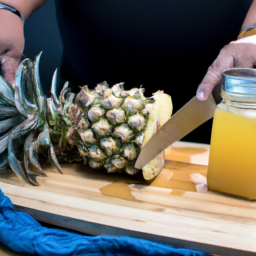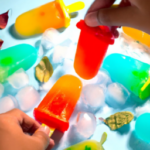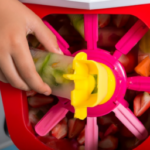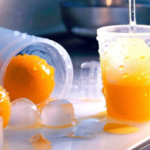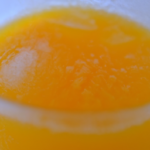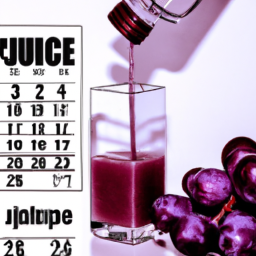Hello, fellow food enthusiasts! Summer is swiftly approaching, and you know what that signifies: it’s time to dust off the popsicle molds and begin experimenting with some chilled, rejuvenating delights.
And what better way to beat the heat than with some homemade orange juice popsicles? In this article, I’m going to take you through the step-by-step process of making delicious and healthy orange juice popsicles that are perfect for any summer day.
With just a few simple ingredients and some patience, you’ll have a tasty treat that is sure to please both kids and adults alike. So, grab your popsicle molds and let’s get started!
Key Takeaways
- Homemade orange juice popsicles are a healthy and refreshing treat perfect for hot summer days.
- Natural sweeteners like honey or agave nectar can be used to balance the sweetness of the orange juice.
- Optional ingredients like fruit, herbs, or even heavy cream can add flavor and texture variations to the popsicles.
- Proper storage and labeling of popsicles is crucial to prevent freezer burn and ensure the best taste and texture.
Gather Your Ingredients
Now that you know what you need, it’s time to gather your ingredients for making delicious orange juice popsicles!
To make sure your popsicles are flavorful, you can experiment with different variations of orange juice. You can use freshly squeezed orange juice, or you can opt for store-bought. You can also mix different types of orange juice to create a unique flavor.
Aside from orange juice, you also need to choose a sweetener to add to your popsicles. There are different types of sweeteners you can use, such as honey, agave syrup, or sugar. If you’re trying to avoid processed sugars, you can use natural sweeteners like maple syrup or stevia.
Once you have your orange juice and sweetener, you’re ready to move on to the next step of making delicious popsicles!
Mix the Ingredients
Now that I’ve gathered all my ingredients, it’s time to mix them together.
I start by pouring the orange juice into a mixing bowl and adding the sweetener. I like to use honey as my sweetener of choice, but you can use any sweetener you prefer.
Once the orange juice and sweetener are combined, I like to add some optional ingredients like chopped fruit or herbs to give the popsicles an extra burst of flavor.
Combine Orange Juice and Sweetener
Next, you’ll want to add a touch of sweetness to your orange juice by mixing in some honey or agave nectar for a deliciously balanced flavor that will hit the spot on a hot summer day. Using natural sweeteners like honey or agave nectar has many benefits.
Not only are they healthier alternatives to traditional sweeteners, but they also enhance the flavor of the orange juice without overpowering it. When adding the sweetener, start off by adding a small amount and taste test as you go.
You want just enough sweetness to make the orange juice enjoyable but not too much that it becomes too sugary. Once you have the perfect balance of sweetness, pour the mixture into your popsicle molds and add optional ingredients like sliced fruit or herbs for an extra burst of flavor.
Remember, the key to a great orange juice popsicle is balance, so take your time and experiment with different amounts of sweetener until you find the perfect combination. With a little patience and creativity, you’ll have a delicious treat that will cool you down on a hot summer day.
Add Optional Ingredients
To take your orange juice popsicles to the next level, you can add some optional ingredients. I like to add sliced fruits and herbs for an extra burst of flavor. Here are some flavor combinations that you can try:
| Fruit | Herb | Health Benefits |
|---|---|---|
| Strawberry | Mint | High in antioxidants |
| Mango | Basil | Rich in vitamin C |
| Pineapple | Rosemary | Anti-inflammatory |
| Kiwi | Thyme | Boosts immune system |
Adding these ingredients not only enhances the taste, but also provides additional health benefits. Once you have chosen your favorite combination, simply mix them into the orange juice and sweetener mixture before pouring them into the popsicle molds.
Now that you have added your optional ingredients, it’s time to pour the mixture into popsicle molds.
Pour the Mixture into Popsicle Molds
Simply pour the orange juice mixture into the popsicle molds, making sure to leave a little bit of room at the top for expansion. If you don’t have popsicle molds, there are alternatives like using small paper cups or ice cube trays. Get creative with your presentation by adding slices of fresh fruit or using different colored juices for a fun and vibrant look.
Once you’ve filled the molds, place them in the freezer for about an hour until they start to set. Then, insert popsicle sticks into the center of each mold. Make sure the sticks are straight and centered so that the popsicles freeze evenly.
Now, you can return the molds to the freezer and allow them to freeze completely, usually for about 4-6 hours.
Add Popsicle Sticks
After freezing the orange juice mixture for an hour, it’s time to add the popsicle sticks. Inserting the sticks may seem like a simple task, but it’s important to ensure they are placed correctly to freeze evenly.
Start by gently placing the stick into the center of the popsicle mold, making sure it’s standing upright and not leaning to one side. If the stick isn’t standing straight, the popsicle will freeze at an angle and may be difficult to remove from the mold.
Once the sticks are inserted, it’s time to get creative with decorating options. You can add chopped fruit, sprinkles, or even a drizzle of chocolate before freezing. If you don’t have popsicle sticks on hand, try using plastic spoons or wooden skewers as an alternative. Just be sure to insert them into the center of the popsicle mold and freeze as usual.
Now that the sticks are in place and any optional decorations have been added, it’s time to let the popsicles freeze completely.
Without any further ado, let’s move on to the next step of the process and freeze the popsicles until solid.
Freeze the Popsicles
I love making popsicles, especially with fresh orange juice. Once the popsicle sticks are in place, the next step is to freeze them. It’s important to keep in mind that the ideal freezing time for popsicles is typically around 4-6 hours, depending on the size and ingredients used.
To avoid freezer burn, it’s best to cover the popsicles with plastic wrap or store them in an airtight container.
Ideal Freezing Time
For the perfect orange juice popsicles, it’s important to know the ideal freezing time. The optimal temperature for freezing is at least -18°C or 0°F. This ensures that the popsicles freeze completely and maintain their shape and texture. It’s also important to use the right freezing techniques to ensure that the popsicles freeze evenly. Here’s a table that shows the ideal freezing time for different types of popsicle molds:
| Type of Popsicle Mold | Ideal Freezing Time |
|---|---|
| Plastic molds | 4-6 hours |
| Silicone molds | 6-8 hours |
| Metal molds | 8-10 hours |
| Paper cups | 8-10 hours |
| Ice cube trays | 2-4 hours |
By following the ideal freezing time for your popsicle mold, you can avoid the risk of under or over-freezing. Under-freezing can result in a slushy texture, while over-freezing can cause the popsicles to become too hard and icy. Once the popsicles are fully frozen, it’s important to store them properly to avoid freezer burn.
Avoid Freezer Burn
To keep your frozen orange juice popsicles at their best, proper storage is crucial. Freezer burn can ruin any frozen treat, making it dry, tasteless, and unappetizing. Thankfully, there are a few simple tips to follow to prevent this from happening.
Firstly, make sure your popsicles are completely frozen before storing them. Partially frozen treats are more susceptible to freezer burn. Once they’re frozen, wrap them tightly in plastic wrap or aluminum foil, or place them in an airtight container. This’ll prevent any air from reaching the popsicles and causing freezer burn.
Finally, keep them stored in the coldest part of your freezer, away from any warm spots or areas where the temperature fluctuates. By following these tips for long-term storage, your orange juice popsicles’ll stay fresh and delicious for weeks to come.
Now that your popsicles’re properly stored, it’s time to remove them from the molds.
Remove the Popsicles from the Molds
Gently wiggle the popsicle mold to loosen the orange juice popsicles from the sides. This step is crucial to prevent breakage when removing the popsicles from the molds. If you find that the popsicles are still stuck after wiggling, try running the mold under warm water for a few seconds to loosen them up.
As you remove the popsicles from the molds, be sure to handle them carefully to prevent any breakage.
Once all the popsicles are out of the molds, you can move on to the next step of adding toppings.
Optional: Add Toppings
If you’re feeling creative, go ahead and jazz up your popsicles with toppings like crushed nuts or mini chocolate chips. Adding toppings not only enhances the flavor but also makes for a creative presentation that is sure to impress your guests.
Here are some toppings ideas to get you started:
- Sprinkle some toasted coconut flakes on top for a tropical twist.
- Drizzle some honey or caramel sauce for a sweet and decadent treat.
- Crush some graham crackers and sprinkle them over the popsicles for a nostalgic campfire flavor.
Once you’ve added your desired toppings, place the popsicles back in the freezer until they are completely frozen.
Now that your popsicles are ready to serve, it’s time to enjoy them with your loved ones!
Serve and Enjoy!
Now it’s time to savor the frozen treats and relish the burst of flavors as I sink my teeth into the icy goodness of the orange juice popsicles. I love how refreshing and sweet these popsicles taste, especially on a hot summer day.
But why stop at just plain old orange juice popsicles? There are plenty of creative serving ideas that can make these treats even more enjoyable. For example, I can sprinkle some chopped nuts or chocolate chips on top of the popsicles for an added crunch. Or, I can dip the popsicles in melted chocolate and roll them in coconut flakes for a tropical twist. The possibilities are endless!
In addition to being a delicious treat, orange juice popsicles also come with some great health benefits. Oranges are rich in vitamin C, which can help boost the immune system and promote healthy skin. They also contain antioxidants that can protect against cell damage and reduce the risk of chronic diseases. So not only am I indulging in a tasty treat, but I’m also giving my body a little extra boost of nutrients.
Now, onto the next section about storage tips.
Storage Tips
Now that we’ve made our delicious orange juice popsicles, it’s important to know how to store them properly.
To keep them fresh and tasty, I always make sure to keep them in the freezer. This ensures that they won’t melt and lose their shape.
Additionally, it’s best to use them within a few weeks to ensure they’re still enjoyable.
Keep in Freezer
Simply pop your freshly made orange juice popsicles into the freezer and wait patiently for them to freeze. It’s important to keep them in the freezer for long term storage, to prevent freezer crystals from forming on the surface. Freezer crystals can cause the texture of the popsicles to become gritty and unpleasant, so it’s best to avoid them if possible.
To ensure that your orange juice popsicles are in the best possible condition when you’re ready to enjoy them, follow these tips for keeping them in the freezer:
-
Store the popsicles in an airtight container to prevent freezer burn.
-
Place the container in the back of the freezer, where the temperature is most consistent.
-
Avoid opening the freezer door unnecessarily, as this can cause temperature fluctuations.
-
Use the popsicles within a few weeks for optimal taste and texture.
With these storage tips in mind, you can enjoy your homemade orange juice popsicles anytime you like.
In the next section, we’ll talk about how to use them within a few weeks to ensure that they’re always fresh and delicious.
Use Within a Few Weeks
To maintain the freshness and taste of your homemade orange juice popsicles, it’s important to use them within a few weeks of freezing. You can also extend their shelf life by storing them properly.
The best way to store homemade popsicles is to place them in an airtight container or plastic bag before putting them in the freezer. This will prevent freezer burn and any unwanted flavors from seeping in. Another tip on how to extend shelf life of popsicles is to label them with the date they were made and the flavor.
This will help you keep track of which popsicles need to be used up first and which ones can be saved for later. Don’t forget to rotate the container or bag every once in a while to ensure even freezing. With these simple steps, you can enjoy your homemade orange juice popsicles for weeks to come.
As for the next step, why not experiment with different flavors and variations? There are endless possibilities when it comes to making popsicles, so let your creativity run wild and try out new recipes.
Experiment with Different Flavors and Variations
If you’re feeling adventurous, why not spice up your orange juice popsicles with some unexpected flavors and creative variations? Flavor combinations can take your popsicles to the next level and make them stand out from the usual orange juice popsicles.
Here are three ideas to get you started:
-
Add a twist of lime: Squeeze some fresh lime juice into your orange juice mixture before freezing. This will give your popsicles a tangy kick and a refreshing twist.
-
Mix it up with berries: Add some fresh berries, such as strawberries or raspberries, to your orange juice mixture before freezing. Not only will this add a burst of flavor, but it will also create a beautiful marbled effect.
-
Go creamy with vanilla: Add a splash of vanilla extract and some heavy cream to your orange juice mixture before freezing. This will create a creamy, dreamy popsicle that tastes like a creamsicle.
Don’t be afraid to get creative and experiment with different flavor combinations. Taste testing is the key to finding the perfect balance of flavors and creating a popsicle that you truly love. So, grab some ingredients and start mixing – the possibilities are endless!
Frequently Asked Questions
Can I use store-bought orange juice instead of freshly squeezed?
I personally prefer using freshly squeezed orange juice for popsicles because it has a more natural taste and is free of added preservatives. However, if you’re in a rush, store bought can work too. A taste test can help determine which you prefer.
How long does it take for the popsicles to freeze completely?
How long does it take for the popsicles to freeze completely? It takes about 4-6 hours for the popsicles to freeze completely, depending on the temperature of your freezer. Freezing time impacts the popsicle texture, so make sure to not rush the process.
Can I add other fruits to the orange juice mixture?
Yes, I love mixing fruits to create unique flavor combinations. Adding strawberries or pineapple to the orange juice mixture can give your popsicles a refreshing twist. Just make sure to adjust the sugar level accordingly.
How many popsicles does this recipe make?
These orange juice popsicles make around six to eight servings, depending on the size of your popsicle molds. Recipe variations could include adding diced strawberries or kiwi for a fruity twist. Serving suggestions include serving with a sprinkle of Tajin seasoning for a spicy kick.
Can I use silicone molds instead of plastic ones?
Yes, silicone molds are a great alternative to plastic ones. They are non-toxic, flexible, and easy to clean. The benefits of using silicone molds include their durability, heat resistance, and ability to release popsicles easily.
Conclusion
I can’t wait to make these orange juice popsicles again! They were so easy to make and tasted incredibly refreshing. I loved how the sweet and tangy flavor of the orange juice complemented the creamy texture of the yogurt. Plus, adding a sprinkle of chopped nuts on top added a nice crunch to each bite.
Did you know that popsicles were accidentally invented by an 11-year-old boy in San Francisco in 1905? Frank Epperson left a mixture of powdered soda, water, and a stirring stick on his porch overnight during a cold winter night, and the next morning, he discovered the first popsicle!
Just like Frank, we can all experiment with different flavors and variations to create our own unique popsicle recipes. Who knows, maybe we’ll accidentally invent the next classic frozen treat!
Ilana has been a vegan for over 10 years. She originally made the switch for health reasons, but soon found herself becoming more and more passionate about the ethical and environmental implications of a vegan lifestyle. Ilana is the author of The Graceful Kitchen, a blog all about veganism. She loves to cook up delicious and nutritious vegan meals, and share her recipes with others who are interested in leading a cruelty-free life. Ilana is also a strong advocate for using whole foods as the foundation of a healthy diet, and believes that going vegan is one of the best ways to achieve this.

